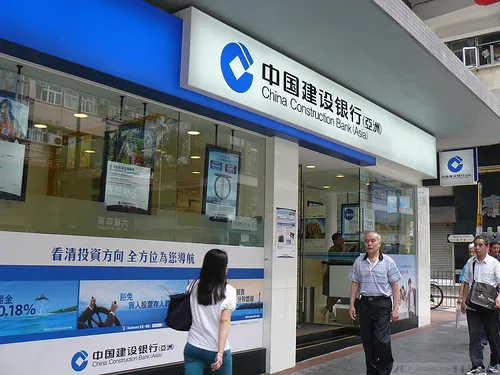
See how China Construction Bank fared in 2012
Net profit increased 14% to RMB 193.2b.
According to Barclays, CCB reported net profit of RMB 193.2bn for 2012, up 14% y/y. The major variance to Barclays' estimate were the higher-than-expected other non interest income of RMB 10.2bn and the higher credit cost (55bps for 2012).
Here's more from Barclays:
Sequential NIM compression of 5bps in 4Q12: We estimate that CCB’s NIM contracted by 5bps q/q to 2.78% in 4Q12, following sequential expansions of 10bps in 2Q12 and 8bps in 3Q12.
We believe the decline was mainly due to faster loan repricing than that for deposits in 4Q12. On an h/h basis, NIM improved by 9bps on the fast falling funding cost (-11bps h/h) and largely stable asset yield (-1bp h/h).
For interest earning asset, the decline in the corporate loan yield (-16bps h/h) and discounted bill rate (-280bps h/h) were offset by the strong overseas loan yield (+63bps), debt security yield (+7bps h/h) and well-held personal loan yield (flat h/h).
While on funding side, broad-based declining yields were seen, especially on corporate demand deposit rate (-14bps h/h) and interbank borrowing yield (-14bps h/h).
Steady deposit growth; benign mix shift to demand deposit: Total deposits rose 2.6% q/q in 4Q12 or 14% y/y in 2012, mainly driven by cheap demand deposits (up 7.4% in 4Q12), now accounting for 51.2% of total deposits (up from 48.9% at end-3Q12), which is a key positive, in our view.
The bank’s principal guaranteed wealth management products decreased by 15% q/q in 4Q12 to RMB 357.7bn from Rmb420bn at end-3Q12 (by our estimate). However, the non-principal guaranteed WMPs increased by 31% q/q to RMB 525bn at end-2012.
In-line loan growth; higher small and micro enterprises loan growth: Total loans were up 3.4% q/q in 4Q12, or 16% y/y in 2012 (its domestic loan growth was in line with system growth of 15% in 2012).
Industry-wise, the bank’s property development loan balance reduced by RMB 2bn h/h in 2H12 to RMB 415.8bn at end-2012, accounting for 5.5% of the bank’s total loan book. LGFV loans decreased by 7% h/h to RMB 411.5bn at end-2012 (5.5% of total loans), and 93.9% of the LGFV loans were fully covered by cash-flows (up from 91.3% at end-1H12).
The bank’s small and micro business loans (under the MIIT classification) increased by 9.4% h/h in 2H12 to Rmb745.5bn at end-FY12, accounting for 10% of total loans.
Recovering fee income growth in 4Q12: The bank’s net fee income grew by 7% y/y to RMB 93.5bn for 2012; and sequentially increased strongly by 14% in 4Q12, following the two weak quarters (+3% q/q in 2Q12 and -17% q/q in 3Q12, due to the negative regulatory tightening rules announced by CBRC in February).
On an h/h basis, the net fee income declined by 10%, which was mainly due to wealth management fees (-33% h/h), agency services (-25% h/h) and consulting fees (-12% h/h). But some strong growth momentum was seen in bank card fees (+21% h/h) and electronic banking fees (+12% h/h).
Asset quality stable; 1-90 day overdue loans declined: NPL balance increased slightly by 2.3% q/q to RMB 74.6bn, and the NPL ratio went down by 1bp q/q to 0.99% as of end-2012. However, credit charge was higher-than-expected, at 83bps in 4Q12, which in turn dragged the bottom-line growth.
The collectively assessed provisions declined by 14% y/y, while the new charge for individually assessed loan provisions increased by 57% in 2012.
Industry-wise, the 6% h/h increase in NPL amount was mainly driven by retail and wholesale trade (+55% h/h) and manufacturing sector (+9% h/h): 1-90 day overdue loans declined 29% h/h in 2H12 to RMB 24.7bn as of end-2012.
CCB’s overdue loans over 90 days was RMB 52.4bn as of end-2012 (0.7% of total loans), up 11.5% h/h in 2H12 (slowed down from 33.5% h/h growth in 1H12).
The main growth driver was still Yangtze River Delta area, but with a slower pace of 47% h/h increase (down from 101% increase in 1H12). The general NPL declines in other regions were largely offset by 33% NPL growth in the Yangtze River Delta area in 2H12 (Figure 2).
Solid capital level: The bank’s Tier 1 ratio stood at 11.32% as of end-2012 (-3bps q/q in 4Q12), and the total CAR improved by 45bps q/q to 14.32%, both above regulatory requirements, implying solid capital position and no equity raising needs. The growth in total CAR was partly helped by 5.7% h/h decrease in credit risk-weighted amount for off-balance sheet items.
Regional and segment banking trends: Geographically, while other regions all reported higher growth, led by the western area (+26% y/y), the profit before tax (PBT) from the Yangtze River Delta declined by 10% y/y due to larger provisions.
Business segment wise, personal banking’s PBT increased by 37% to RMB 51.7bn for 2012, accounting for 21% of the bank’s total PBT; while corporate banking is still the main contributor (47% of total PBT).




![Lorem Ipsum [ABF 1]](https://cmg-qa.s3.ap-southeast-1.amazonaws.com/s3fs-public/styles/exclusive_featured_article/public/2025-03/a_hand_pointing_to_a_futuristic_technology_5b87c9d0e3_1.png.webp?itok=2w0y1WhS)


![Cross Domain [Manu + SBR + ABF + ABR + FMCG + HBR + ]](https://cmg-qa.s3.ap-southeast-1.amazonaws.com/s3fs-public/styles/exclusive_featured_article/public/2025-01/earth-3537401_1920_4.jpg.webp?itok=WaRpTJwE)







 Advertise
Advertise

